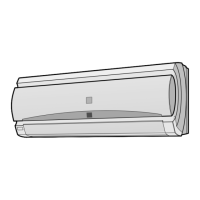AYXP26FRN
3 – 7
5. Louvers do not move
6. There is noise in TV/radio
7. Malfunction occurs
8. Compressor does not start
9. Operation stops after a few minutes and restarts, and this process repeats
CAUTION: If fuse FU1/FU4/FU5 (outdoor unit control circuit board) is blown, be careful of charging voltage in inverter electrolytic capacitor C9, C10.
To discharge stored electricity, unplug the power cord and connect the plug of a soldering iron (230VAC, 50W) between the positive and
negative terminals of inverter electrolytic capacitor C9, C10.
Open-circuit or short-circuit in wir-
ing of light receiving section.
Check if wires of light receiving
section are caught.
Wires of light receiving section
should not have any damage
caused by pinching.
Replace wires of light receiving
section.
Defective light receiving unit. Check signal receiving circuit
(measure voltage between termi-
nals 2 and 3 of connector
BCN3B).
Tester indicator should move
when signal is received.
Replace PWB.
Dew condensation on light receiv-
ing unit.
Check for water and rust. Signal should be received within
range specified in manual.
Take moisture-proof measure for
lead wire outlet of light receiving
section.
Main cause Inspection method Normal value/condition Remedy
Caught in sliding section. Operate to see if louvers are
caught in place.
Louvers should operate smoothly. Remove or correct catching sec-
tion.
Disconnected connector (DCNC,
DCND on relay PWB, louver
motor side)
Inspect connectors. Connectors or pins should not be
disconnected.
Install correctly.
Contact of solder on PWB
(connector section on PWB)
Check visually. There should not be solder con-
tact.
Correct contacting section.
Main cause Inspection method Normal value/condition Remedy
Grounding wires not connected
properly.
Check grounding wire connec-
tions.
Grounding wires should be con-
nected properly.
Connect grounding wires prop-
erly.
TV/radio is placed too close to
outdoor unit.
Check distance between TV/radio
and outdoor unit.
If TV/radio is placed too close, it
may become affected by noise.
Move TV/radio away from outdoor
unit.
Other than above. Check for radio wave interfer-
ence. (See page )
Main cause Inspection method Normal value/condition Remedy
Malfunction caused by noise. Check for radio wave interfer-
ence. (See page )
Main cause Inspection method Normal value/condition Remedy
Erroneous inter-unit connection. Check wiring between indoor and
outdoor units.
Terminal board 1-N: 230 VAC, 50
Hz
Terminal board 2: serial signal
Correct wiring.
Damaged IPM. Check IPM continuity. See on page 8- Replace IPM.
Dried-up electrolytic capacitor. Check electrolytic capacitor. See on page 8- Replace electrolytic capacitor.
Blown outdoor unit fuse. Check 20-A fuse.
Check 15-A fuse.
Fuse should not be blown. Replace fuse/diode bridge.
Replace fuse.
Replace outdoor unit PWB
assembly.
Power supply voltage is too low. Measure power supply voltage
during startup.
230±10 VAC, 50 Hz Make sure that power supply volt-
age is 180 V or higher.
Compressor lock. Supply current and touch com-
pressor cover (sound absorbing
material) to check if operation
starts.
Compressor should start nor-
mally.
Apply external impact to com-
pressor.
Replace compressor.
Main cause Inspection method Normal value/condition Remedy
Dried-up electrolytic capacitor. Measure 320-VDC line voltage. 250 V or higher. Replace electrolytic capacitor.
Layer short-circuit in expansion
valve coil.
Measure resistance. 46±3Ω in each phase (at 20°C) Replace coil.
Main cause Inspection method Normal value/condition Remedy

